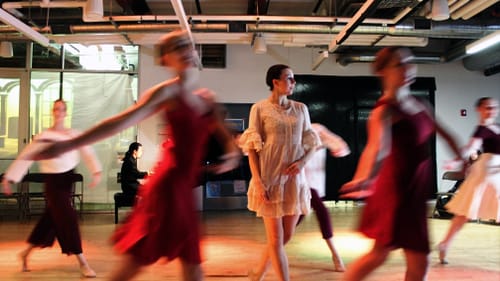Stay in the Loop
BSR publishes on a weekly schedule, with an email newsletter every Wednesday and Thursday morning. There’s no paywall, and subscribing is always free.
Thus with a kiss...
Drexel University presents Sandra Parks and Frederic Chiu's 'Romeo and Juliet -- The Choice'

If we could, would we make Romeo and Juliet live happily ever after instead of dying separated by one cruel moment in time? Romeo & Juliet — The Choice, a performance of Sergei Prokofiev’s Romeo and Juliet at Drexel’s URBN Center, offered audiences the option.
Prokofiev’s original ballet (premiered in Brno in 1938) was pretty provocative. He tried to give it a happy ending. But poor sanguine Prokofiev never got what he wanted. He had to change his ballet to conform to Shakespeare’s tragic ending, so Romeo and Juliet continued their centuries-old tradition of mutual death.
Academics on mic
But the original score of Prokofiev’s happy ending still exists, and prolific recording pianist Frederic Chiu, Drexel’s Westphal College 2018 Rankin Scholar, has both versions at his fingertips. He was the co-producer of The Choice, along with choreographer Sandra Parks, and played either version at the request of the audience’s majority vote, with customized choreography.
Drexel professor of English, writing, and literature Ken Bingham emceed this ambitious event along with Parks. Four Drexel scholars (Dr. Lloyd Ackert, Dr. Paula Marantz Cohen, Dr. Kirsten Kaschock, and Dr. Don Riggs) began the performance by making their cases for or against staging the ballet as Prokofiev originally wanted, contrary to Shakespeare’s text. I admit, with the mic in the hands of five enthusiastic academics plus a ballet, I wondered if the 5:30pm performance would end before midnight.
But the professors kept it admirably brief. Those on the “happy” side argued that the tragic ending is out of character with the play’s light, funny early scenes, and there’s a long history of Shakespeare performances being doctored for reasons like political expediency.
{photo_2}
The pro-death scholars argued for the necessary pathos of untimely demise and the feuding families’ ultimate reconciliation in grief. This, of course, raises the question of what a “happy” ending really is — one in which two teenagers get married (like, married for life, probably in the midst of increasingly fatal stints of public thumb-biting) after a single tryst, or one in which the infatuated teens die a quick death and their extended families move peaceably onward?
Happy or tragic?
To the world-class sounds of Chiu’s solo piano, Drexel’s large ensemble of student dancers performed a version of Prokofiev’s ballet in two acts. Harlee Trautman appeared as Juliet, alongside Chad Allen Ortiz’s Romeo and Jorge Rullán’s Mercutio.
At intermission, audience members could text their choice to a phone number provided in the program: Shakespeare’s “tragic” ending (lovers die), or Prokofiev’s “happy” ending (lovers live)?
I was curious about the happy ending, but that didn’t stop me from voting for death. (Does the world really need another rom-com?)
The performance resumed, and as Romeo discovered Juliet in the vault, the audience tightened with genuine suspense. Romeo stabbed himself. Juliet awoke and likewise dispatched herself. Afterward, Bingham told the audience that 60 percent of us had voted for tragedy (contrary to the previous night, when the vote was for love resurrected).
The great decider
It all left me wondering how we decide on the essentials of anything. Prokofiev’s ballet is called Romeo and Juliet, but there’s no “O trespass sweetly urged! / Give me my sin again.” No words at all, but we’re apparently okay with that.
And none of the Drexel scholars mentioned it, but Shakespeare didn’t exactly make this stuff up himself. He borrowed a patchwork of tragic-lover legends going back to the 12th century at least, with some choice dramatic padding (see Mercutio, whom Prokofiev keeps). But we’re not complaining.

We’re also okay with landing the story in 1950s New York and letting Juliet live. We don’t mind turning it into operas, either. Then there’s Baz Luhrmann’s 1996 film starring Leonardo DiCaprio and Claire Danes, where the “swords” are handguns and sad, beautiful people drive around in limousines.
I was a ‘90s teenager, and Luhrmann’s R&J (played at countless sleepovers on VHS) almost destroyed us because, in his staging, it could be argued that Juliet’s waking gesture startles Romeo into swallowing the poison. She watches him convulse and die. However, I don’t think Paris (a young Paul Rudd) dies. We were totally okay with this.
I guess if you really want to know if you’re expendable, see if you’re alive at the end of a Shakespearean tragedy — especially a screen adaptation.
So how do you figure out the hill you’re willing to die on, in questions of great literature or anything else? According to this thought-provoking performance, death really is the great decider.
Since the 1100s, you could tell this story pretty much any way you wanted to, as long as one of the lovers dies. Even without the blushing pilgrims, at least we know where we stand.
What, When, Where
Romeo & Juliet — The Choice. Choreography by Sandra Parks; Frederic Chiu, piano. November 16-18, 2018, at Drexel University's URBN Center, 3501 Market Street, Philadelphia. (215) 895-2000 or drexel.edu.
Sign up for our newsletter
All of the week's new articles, all in one place. Sign up for the free weekly BSR newsletters, and don't miss a conversation.

 Alaina Johns
Alaina Johns